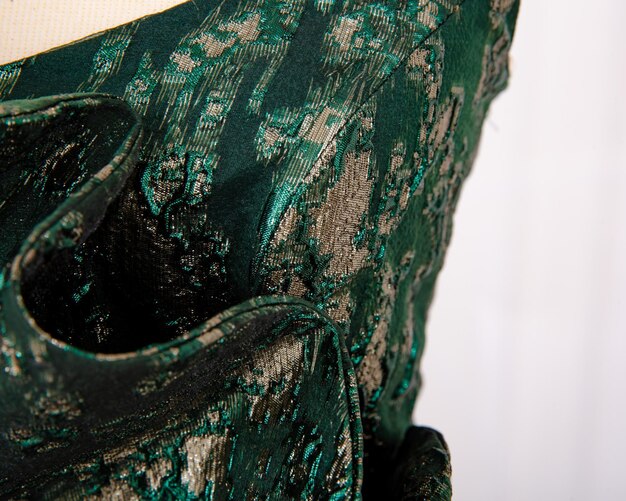The Complete Guide to Caring for Delicate Fabrics in the US

Advertisements
Caring for delicate fabrics like silk, lace, and cashmere requires special attention to maintain their beauty and longevity; this guide provides detailed instructions for washing, drying, ironing, and storing these materials in the US.
Delicate fabrics like silk, lace, and cashmere add a touch of luxury to our wardrobes. However, their delicate nature requires special care to maintain their beauty and longevity. This The Complete Guide to Caring for Delicate Fabrics: Silk, Lace, and Cashmere in the US provides detailed, step-by-step instructions and tips to help you keep these fabrics looking their best, right here in the US.
Advertisements
Understanding Delicate Fabrics
Delicate fabrics have unique compositions that require specific care. Understanding these properties is key to preventing damage during cleaning and storage. Let’s dive into what makes each fabric so special.
Silk: The Luxurious Protein Fiber
Silk is a natural protein fiber produced by silkworms. Its smooth texture and natural sheen make it a highly prized fabric. However, silk is sensitive to heat, light, and friction, which can weaken its fibers and cause discoloration.
Advertisements
Lace: The Intricate Art of Openwork
Lace is characterized by its intricate, openwork design. It can be made from various fibers, including cotton, linen, silk, or synthetic materials. The delicate structure of lace makes it susceptible to snagging and stretching.
Cashmere: The Softest of Wool
Cashmere is a luxurious type of wool obtained from cashmere goats. Known for its exceptional softness and warmth, cashmere fibers are very fine and delicate, requiring gentle handling to prevent pilling and shrinkage.

Understanding these fabrics will allow you to care for them properly. Now, let’s look at general rules on how to always keep your clothes safe and sound.
- Read the Care Label: Always start by checking the garment’s care label for specific instructions from the manufacturer.
- Test for Colorfastness: Before washing any delicate item, test a small, inconspicuous area for colorfastness.
- Use Gentle Detergents: Opt for detergents specifically formulated for delicate fabrics, as they are less likely to cause damage or fading.
By understanding delicate fabrics and following the care guidelines you can prolong the like of expensive outfits, while taking care of the environment.
Washing Delicate Fabrics: A Gentle Approach
Washing delicate fabrics requires a gentle approach to prevent damage. Hand washing and using the delicate cycle on your washing machine are the best options. Let’s explore these in detail.
Hand Washing: The Safest Method
Hand washing is the safest method for cleaning delicate fabrics. It allows you to control the water temperature and the amount of agitation, minimizing the risk of damage. Fill a clean basin with cool water and add a small amount of gentle detergent.
Machine Washing: When to Use the Delicate Cycle
If you choose to machine wash delicate fabrics, use the delicate cycle. This cycle uses cooler water and gentler agitation. Place the item in a mesh laundry bag to protect it further from friction and snagging. Avoid washing delicate items with heavy items like jeans, towels, or anything with zippers.

Make sure that you wash clothing with similar materials, do not mix them with other colors so there isn’t any contamination.
- Use Cool Water: Always use cool water when washing delicate fabrics.
- Avoid Harsh Chemicals: Never use bleach or fabric softeners on delicate fabrics, as they can cause irreversible damage.
- Rinse Thoroughly: Ensure that all detergent is completely rinsed out of the fabric to prevent residue buildup, which can attract dirt and cause discoloration.
Therefore, it’s important to always review the labels to know which material is more adequate for the machine and which needs hand washing.
Drying Delicate Fabrics: Avoiding Heat Damage
Drying delicate fabrics requires avoiding heat, which can cause shrinkage, damage, and distortion. Air drying is the preferred method, but there are specific techniques to follow.
Air Drying: The Gentle Option
Air drying is the gentlest way to dry delicate fabrics. Lay the item flat on a clean, dry towel or hang it on a padded hanger away from direct sunlight and heat. Avoid using clothespins, as they can leave marks on the fabric.
Using a Tumble Dryer: A Last Resort
If you must use a tumble dryer, select the lowest heat setting and place the item in a mesh laundry bag. Check the item frequently to prevent overdrying. However, air drying is strongly recommended for most delicate fabrics.
Take into account that you CANNOT tumble dry delicate fabric. So avoid this measure.
- Avoid Direct Sunlight: Direct sunlight can fade and damage delicate fabrics.
- Do Not Wring or Twist: Wringing or twisting can stretch and distort the fabric.
- Use a Drying Rack: A drying rack allows air to circulate around the item, speeding up the drying process.
With all these tips, you are ready to dry any delicate fabric, but patience is key. Also, remember to check the weather to guarantee that you protect the fabric from the sunlight.
Ironing Delicate Fabrics: Low and Slow
Ironing delicate fabrics requires a low-heat setting and a protective barrier. Always check the garment’s care label for specific ironing instructions. We will provide tips to iron silk, lace and cashmere.
Silk: Pressing for Perfection
Iron silk on the lowest heat setting while it is still slightly damp. Use a pressing cloth to protect the fabric from direct heat. Iron on the reverse side to prevent shine.
Lace: Handle with Care
Lace is very delicate and can easily be damaged by heat. If ironing is necessary, use the lowest heat setting and a pressing cloth. Alternatively, you can steam the lace to remove wrinkles.
Cashmere: Avoiding Damage
Cashmere rarely needs ironing. If necessary, use a cool iron and a pressing cloth. Iron the garment inside out to avoid damaging the fibers. Steaming is also a good option for removing wrinkles from cashmere.
If you’re in a hurry, steaming is a good option, you still will have to use a piece of fabric/cotton to make sure that the fabric doesn’t get burned.
- Use a Pressing Cloth: A pressing cloth protects the fabric from direct heat and prevents scorching.
- Iron on Low Heat: Always use the lowest heat setting to prevent damage.
- Avoid Over-Ironing: Over-ironing can weaken the fibers and cause damage.
With a low heat and doing it slowly, you can iron the fabric as perfect as possible without damaging it.
Storing Delicate Fabrics: Preserving Quality
Proper storage is crucial for preserving the quality of delicate fabrics. Protect them from pests, moisture, and light. Let’s discuss the best storage practices.
Protecting from Pests
Moths and other pests can damage delicate fabrics. Store items in airtight containers or garment bags. Use cedar chips or lavender sachets to repel pests naturally.
Avoiding Moisture
Moisture can cause mildew and damage delicate fabrics. Store items in a cool, dry place. Use moisture-absorbing products like silica gel packs to keep items dry.
Shielding from Light
Light can fade and weaken delicate fabrics. Store items in dark closets or use blackout curtains to protect them from sunlight.
In the event that you had clothing in the storage for ages, air them a little bit out of direct sunlight for at least 72 hrs.
- Use Padded Hangers: Padded hangers prevent shoulder indentations and protect the shape of garments.
- Fold Carefully: Fold delicate fabrics carefully to avoid creases and wrinkles.
- Store in Breathable Bags: Use breathable cotton or muslin bags to protect items from dust and pests while allowing air circulation.
In conclusion, always store delicate fabrics with the best practices possible, so they will last longer than ever.
Repair and Maintenance
Regular repair and maintenance can extend the life of delicate fabrics. Here are some essential tips to keep your items in top condition throughout the US.
Addressing Snags and Tears
Repair snags and tears as soon as possible to prevent further damage. Use a fine needle and thread that matches the fabric’s color. For lace, carefully weave the thread through the existing pattern to conceal the repair.
Dealing with Stains
Treat stains immediately to prevent them from setting. Use a gentle stain remover specifically formulated for delicate fabrics. Test the stain remover on an inconspicuous area first to ensure it does not cause discoloration.
Refreshing Odors
To freshen up delicate fabrics, hang them in a well-ventilated area. You can also use a fabric refresher spray, but test it on an inconspicuous area first. Avoid using harsh chemicals or perfumes directly on the fabric.
Another pro tip, is that clothing that is heavily used should be washed regularly, and aired frequently so they are always clean.
- Regular Inspections: Regularly inspect your delicate items for signs of wear and tear.
- Professional Cleaning: Consider professional cleaning for valuable or heavily soiled items.
- Proper Storage: Store your delicate fabrics properly when not in use to prevent damage.
Finally, with these tips and the right tools your clothing collection will last as long as you want. Let’s take a look at some facts for people quick on the go.
| Key Point | Brief Description |
|---|---|
| 🧼 Gentle Washing | Use cool water and gentle detergents for hand or machine washing. |
| 🌬️ Air Drying | Air dry delicate fabrics away from direct sunlight and heat. |
| 🔥 Low Heat Ironing | Use a low heat setting and a pressing cloth when ironing. |
| 🧽 Careful Storage | Store in a cool, dry place, protected from pests, moisture, and light. |
FAQ
▼
Yes, silk can be machine washed on a delicate cycle using a mesh laundry bag and a gentle detergent. However, hand washing is generally safer for delicate items.
▼
Cashmere sweaters don’t need to be washed after every wear. Washing them every 2-3 wears, or when noticeably soiled, is usually sufficient to maintain their quality.
▼
Steaming is the best way to remove wrinkles from lace. You can also use a cool iron with a pressing cloth, but be very careful to avoid damaging the lace.
▼
No, regular detergents can be too harsh for delicate fabrics. Always use a detergent specifically formulated for delicate fabrics to prevent damage, fading, or discoloration.
▼
Store delicate fabrics in airtight containers or garment bags with cedar chips or lavender sachets to repel moths. Ensure the items are clean and dry before storing them.
Conclusion
Caring for delicate fabrics like silk, lace, and cashmere doesn’t have to be daunting. By following these detailed steps and tips, you can ensure your favorite delicate fabrics remain beautiful and last longer! Remember to always take extra precautions and care.